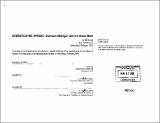Domesticating sprawl : Dearborn Michigan and the Green Moat
Author(s)
Law, Marie (Marie Lynne)
DownloadFull printable version (20.34Mb)
Other Contributors
Massachusetts Institute of Technology. Dept. of Architecture.
Advisor
Ann Pendleton-Jullian.
Terms of use
Metadata
Show full item recordAbstract
Over the last century of urban decentralization, the suburb migrated a critical distance beyond the traditional city, and transformed into sprawl. The homogenous landscape of sprawl is characterized by repeating horizontal imagery of featureless buildings foregrounded with grass berms, planned for experience through the mediating frame of the car's windshield. Contemporary design discourse has interrogated sprawl from many angles in search for ways to intervene in the most popular and most impenetrable form of American urbanism, issuing discussions ranging from those that raise polar alternatives to those that accept sprawl and meticulously analyze its forms and structure. However, this thesis asserts that the American Midwest is a unique and important territory that has not been adequately appraised in the sprawl debate. Not only does the underlying structure and ideology of Midwesternr landscape evoke certain comparisons to sprawl, one might argue that the American suburb was first borne out of the Midwest, more specifically around the Motor City Detroit. If the automobile is the enabling apparatus of sprawl, the birthplace of the automobile then coincides with the birthplace of the suburb. As both the originating source of suburban development and a current scene of booming sprawl, the metropolitan region of Detroit sees the confluence of the new and the old forms of decentralized urbanism and is accordingly an excellent proving ground for new insights and proposals. (cont.) The project is sited at the zone of convergence between the 'edge' of Detroit, the first-growth suburban fabric of Dearborn, Michigan, and the ongoing sprawl of the Ford Motor Company. Rejecting the standard tabula rasa approach to sites of decentralized urbanism, this thesis evaluates the formal and social structures affected by sprawl as embedded and potentially meaningful contextual frameworks for design. Therefore, research and creative re-description are conceptualized as integral aspects of the design proposal. The investigation informs a hybridized morphological system that generates more fluid interrelationships between the presently disparate forms of decentralized urbanism in this context.
Description
Thesis (M. Arch.)--Massachusetts Institute of Technology, Dept. of Architecture, 2006. Includes bibliographical references (p. 98-101).
Date issued
2006Department
Massachusetts Institute of Technology. Department of ArchitecturePublisher
Massachusetts Institute of Technology
Keywords
Architecture.